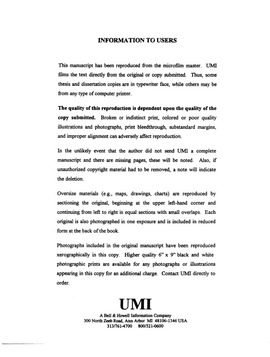| dc.contributor.advisor | Langenbach, Michael, | en_US |
| dc.contributor.author | Young, Dalton L., Iii. | en_US |
| dc.date.accessioned | 2013-08-16T12:30:07Z | |
| dc.date.available | 2013-08-16T12:30:07Z | |
| dc.date.issued | 1998 | en_US |
| dc.identifier.uri | https://hdl.handle.net/11244/5673 | |
| dc.description.abstract | In future studies, researchers might investigate perceptions of consumers (i.e., the students) toward the program. Also, an investigation comparing development of a product oriented (e.g., new buildings, new staff, new rules) program with a process-oriented program (e.g., new connections to existing services) merits further consideration. | en_US |
| dc.description.abstract | The author interviewed individuals who worked with students who accessed the program under investigation. Previous studies cited funding, planning, training, and "turf" issues as barriers to collaborative projects. However, barriers to the "independent livers" program were more subtle. Participants emphasized manpower, priorities, public opinion, and one-on-one interaction as obstacles to collaboration. | en_US |
| dc.description.abstract | The present study reports the investigation of barriers in developing a program for independent living students at a public high school. Services for Independent Living Students, Inc. provides an access point to community services. The access point makes students aware of what services exist in Thatton, the fictional name of a Southwestern city in the United States. The program often "brings" the service to the student. Students that access the program typically have been emancipated by the court system, abused or neglected, or have escaped a toxic home environment. | en_US |
| dc.description.abstract | In general, participants agreed that two factors influenced the beginnings of the "independent living" program, a mayor's task force and a project at a state university. Services for Independent Living Students, Inc. makes use of existing services and agencies within the city, county, and state. In other words, new services are not created. Therefore, the program in Thatton required neither new funding nor new paid personnel. | en_US |
| dc.description.abstract | Barriers noted by participants did not exactly match the barriers cited by previous authors. However, they did fit into the same categories. Specifically, the barriers to the independent living students program appeared as more targeted descriptions of barriers than previous authors have written about. For example, previous studies noted turf issues as a significant barrier. The study reported herein found that the lack of one-on-one interactions created difficulty for the independent living program. In a study that did not take into account the perceptions of those individuals who work with students, problems that developed due to lack of communication might have later been attributed to turf issues. However, to quote one participant, "Turf issues were not present once people had spent some 'face time' with one another." | en_US |
| dc.format.extent | xi, 119 leaves ; | en_US |
| dc.subject | Community and school United States. | en_US |
| dc.subject | Students Services for United States. | en_US |
| dc.subject | Sociology, Public and Social Welfare. | en_US |
| dc.subject | Child welfare United States. | en_US |
| dc.subject | Sociology, Individual and Family Studies. | en_US |
| dc.subject | Education, Administration. | en_US |
| dc.title | An investigation into the barriers to interagency collaboration in a project for homeless and independent living students. | en_US |
| dc.type | Thesis | en_US |
| dc.thesis.degree | Ph.D. | en_US |
| dc.thesis.degreeDiscipline | Department of Educational Leadership and Policy Studies | en_US |
| dc.note | Source: Dissertation Abstracts International, Volume: 59-07, Section: A, page: 2295. | en_US |
| dc.note | Adviser: Michael Langenbach. | en_US |
| ou.identifier | (UMI)AAI9839807 | en_US |
| ou.group | Jeannine Rainbolt College of Education::Department of Educational Leadership and Policy Studies | |
